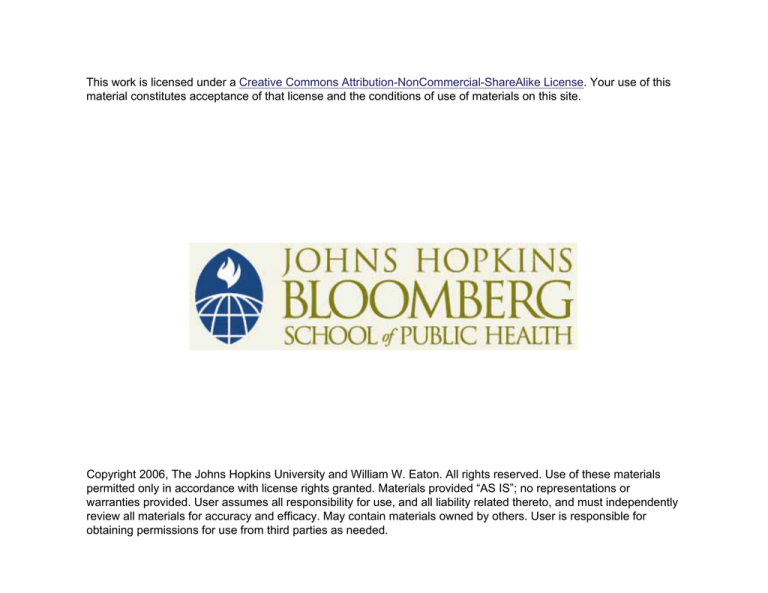
This work is licensed under a Creative Commons Attribution-NonCommercial-ShareAlike License. Your use of this
material constitutes acceptance of that license and the conditions of use of materials on this site.
Copyright 2006, The Johns Hopkins University and William W. Eaton. All rights reserved. Use of these materials
permitted only in accordance with license rights granted. Materials provided “AS IS”; no representations or
warranties provided. User assumes all responsibility for use, and all liability related thereto, and must independently
review all materials for accuracy and efficacy. May contain materials owned by others. User is responsible for
obtaining permissions for use from third parties as needed.
Epidemiology of Mood Disorders II:
Analytic Epidemiology and
the Search for Etiologic Clues
William W. Eaton, PhD
Johns Hopkins University
Epidemiology of Depression Risk Factors
Sex/gender and natural history
Diathesis/stress model
Life event stressors
Social supports
Continued
3
Epidemiology of Depression Risk Factors
Socioeconomic status (SES) and work life
SES, social supports, and life stage
Recency of birth
4
Section A
Gender
Gender and Mood Disorders in Four Surveys
Ages 26-64, Standardized to U.S. Age Distribution
MDD--Males
BPD--Males
Lifetime Prevalence (%)
20
3.47/1
1.76/1
15
10
2.3/1
5
1.25/1
0
MDD--Females
BPD--Females
1.98/1
USA
Data from: Weissman, et al. (1993), J Affect Disord.
.86/1
Edmonton
NA
Munich
.91/1
New Zealand
6
Risk Factors for Adult MDE
Forest Plot
Breslau, 1996
Catalano, 2000
Ginexi, 2000
Female vs. Male
Hwang, 2000
Kawakami, 1995
Messias, 2001
Patten, 2001
Pine, 1998
.6 .8 1
2
4
6
8 10
20
Relative Risk/Odds Ratio
Adapted from: Mielke et al, 2002
7
Incidence, Recurrence, and Duration by Age and Sex
Baltimore ECA Follow-Up
Male
Female
Incidence Recurrence
RR
RR
1
1
1.98
0.95
Duration
in Weeks
0
4.23
18-29
30-44
45+
1
0.64
0.18
1
0.75
0.11
0
7.98
-0.23
Recurrence
***
***
-11.25
Source: Eaton, et al. (1997), Arch Gen Psychiatry
8
Summary
Prevalence of depression is higher in females than
males
Caused by relationship of incidence of depression to
gender
Gender operates only in the first episode
9
Section B
Stress, Heredity, and Social Support
Diathesis Stress Model
11
. . . in London
Percent with Severe Events Prior to Onset
Cases
(Patients)
Cases
(Survey)
Controls
(Survey)
61%
68%
20%
39%
32%
80%
Total Percent
100%
100%
100%
Number of
Persons
114
76
382
One or More
Severe Events
No Severe
Events
Source: Brown and Harris (1978), Social Origins of Depression, pp. 57-58, 103
12
Interaction of Life Events and Heredity
Onset of Major Depression in 2,164 Female Twins
Percent with Onset
16
14
12
10
DZ Co-Twin Normal
MZ Co-Twin Normal
DZ Co-Twin Case
MZ Co-Twin Case
8
6
4
2
0
Absent
Present
Severe Life Event in Month of Onset
Adapted from Kendler et al. (1995), Am J Psychiatry
13
Support
Percent with
Onset of Disorder
Confidant
No Confidant
No Recent Life
Stress
1%
3%
Recent Life Stress
4%
38%
Source: Brown, et al. (1975), Sociology
14
Section C
SES, Work, and Life Stage
Odds Ratios for Prevalence of Major Depression
in the Lower Socio-Economic Group
Adapted from: Lorant, et al. (2003), Am J Epidemiol.
16
Odds Ratios of Major Depression
Five Incidence and Four Persistence Studies
Adapted from: Lorant, et al. (2003), Am J Epidemiol.
17
Predictors of Episodes of Depression
Baseline (1981)
Background Prevalence
Family Background
Father’s job percentile
Father’s grade level
Parental Depression
Highest grade, baseline
Job percentile of first job
1.00
.99*
1.91+
.90*
1.00
Occupational Career
Job percentile at baseline
Household income percentile, baseline
Financial dependency at baseline
Job percentile at Follow-up
Household income percentile, follow-up
Other income, follow-up
Prior year life events
* p < .1
** p < .05
Data from: Eaton, et al. (2001), J Health Soc Behav
1.01
.99*
1.77***
.91
1.00
1.59**
.92
1.76**
.89
1.00
.99
1.00
1.00
1.00
1.00
1.75
2.42***
1.00
1.00
2.46**
1.00
1.00
.61
1.59***
.89
1.88+
1.55*
*** p < .01
Follow-Up (1993-96)
Prevalence Incidence
+ p < .005
Continued
18
Predictors of Episodes of Depression
Baseline (1981)
Background Prevalence
Family Background
Father’s job percentile
Father’s grade level
Parental Depression
Highest grade, baseline
Job percentile of first job
1.00
.99*
1.91+
.90*
1.00
Occupational Career
Job percentile at baseline
Household income percentile, baseline
Financial dependency at baseline
Job percentile at Follow-up
Household income percentile, follow-up
Other income, follow-up
Prior year life events
* p < .1
** p < .05
Data from: Eaton, et al. (2001), J Health Soc Behav
1.01
.99*
1.77***
.91
1.00
1.59**
.92
1.76**
.89
1.00
.99
1.00
1.00
1.00
1.00
1.75
2.42***
1.00
1.00
2.46**
1.00
1.00
.61
1.59***
.89
1.88+
1.55*
*** p < .01
Follow-Up (1993-96)
Prevalence Incidence
+ p < .005
19
100
Middle Class
80
80
Lower Class
60
100
60
40
40
Lower Class
20
6 t ild
o 1 ren
4
Ch
a n ild
d ren
Ov 1
er 5
Ol
Ch der
ild , N
re o
n
Ch
Yo
Ch
t h ild
a n Le
S i x ss
0
20
Middle Class
0
Percent with Confidant (Top)
Social Class, Life Stage, and Intimacy
No un
Ch g,
i ld
re
n
Percent with Depression (Bottom)
Depression among Women in London
Life Stage
Redrawn from Brown, Bhrolchain, and Harris (1975)
Continued
20
100
Middle Class
80
80
Lower Class
60
100
60
40
40
Lower Class
20
6 t ild
o 1 ren
4
Ch
a n ild
d ren
Ov 1
er 5
Ol
Ch der
ild , N
re o
n
Ch
Yo
Ch
t h ild
a n Le
S i x ss
0
20
Middle Class
0
Percent with Confidant (Top)
Social Class, Life Stage, and Intimacy
No un
Ch g,
i ld
re
n
Percent with Depression (Bottom)
Depression among Women in London
Life Stage
Redrawn from Brown, Bhrolchain, and Harris (1975)
21
Risk Factors for Adult MDE
Work Environment
Job Overload
Job Unsuitability
Absenteeism from Work
Absenteeism from Work
High Psychological Demand
High Psychological Demand
Low Decision Latitude
Low Decision Latitude
High Job Strain
High Job Strain
High Job Insecurity
High Job Insecurity
Low Supervisor Support
Low Supervisor Support
Color Category
Forest Plot
Redrawn from Mielke, et al. (2002)
a
a
b
b
b
b
b
b
c
c
c
c
c
c
.1
.2 .3 .4.5
1
2 3 45
10
20 30
Relative Risk/Odds Ratio
22
Section D
Recency of Birth
Cumulative Percent Ever Depressed
Birth Cohort
Females in Five ECA Sites
0.2
1955-1964
0.15
1945-1954
Births after 1935
1935-1944
1925-1934
0.1
Births before 1935
1915-1924
1905-1914
0.05
0
0-04
0-14
15-24
25-34
35-44
44-54
Age in Years
Redrawn from Wickramaratne, et al. (1989), J Clin Epidemiol.
55-64
65-74
24
Community Settings the Cohort Effect Has Appeared
Five urban areas in the
United States
Paris, France
Beirut, Lebanon
Edmonton, Alberta
Christchurch, New Zealand
Puerto Rico
Taiwan
Munich Germany
Florence, Italy
Source: Cross-National Collaborative Group, JAMA (1992)
25
Possible Explanations for Cohort Effects
Older cohorts are less introspective
More treatment available leads to better recall
People with depression die sooner
Older subjects forget more distant episodes
26
Recall Simulation and Major Depression
1% of Episodes Forgotten Each Year
Redrawn from Giuffra and Risch (1994), Psycho Med.
Continued
27
Recall Simulation and Major Depression
3% of Episodes Forgotten Each Year
Redrawn from Giuffra and Risch (1994), Psycho Med.
Continued
28
Recall Simulation and Major Depression
Forgetting Increases with Age Cohort:
1900, 10%; 1930, 5%; 1960, 1%
Redrawn from Giuffra and Risch (1994), Psycho Med.
29
Trends in Incidence of Depressive Disorder
30
Trend in Suicide among Youth
Rates per 100,000 Population
16
14
12
Holland 20-29
US 15-24
Rate
10
8
6
4
2
Born after 1945
0
1900 1910 1920 1930 1940 1950 1960 1970 1980 1990
Year of Suicide
Adapted from: Diekstra (1993), Acta Psychiatr Scand Supl
31





